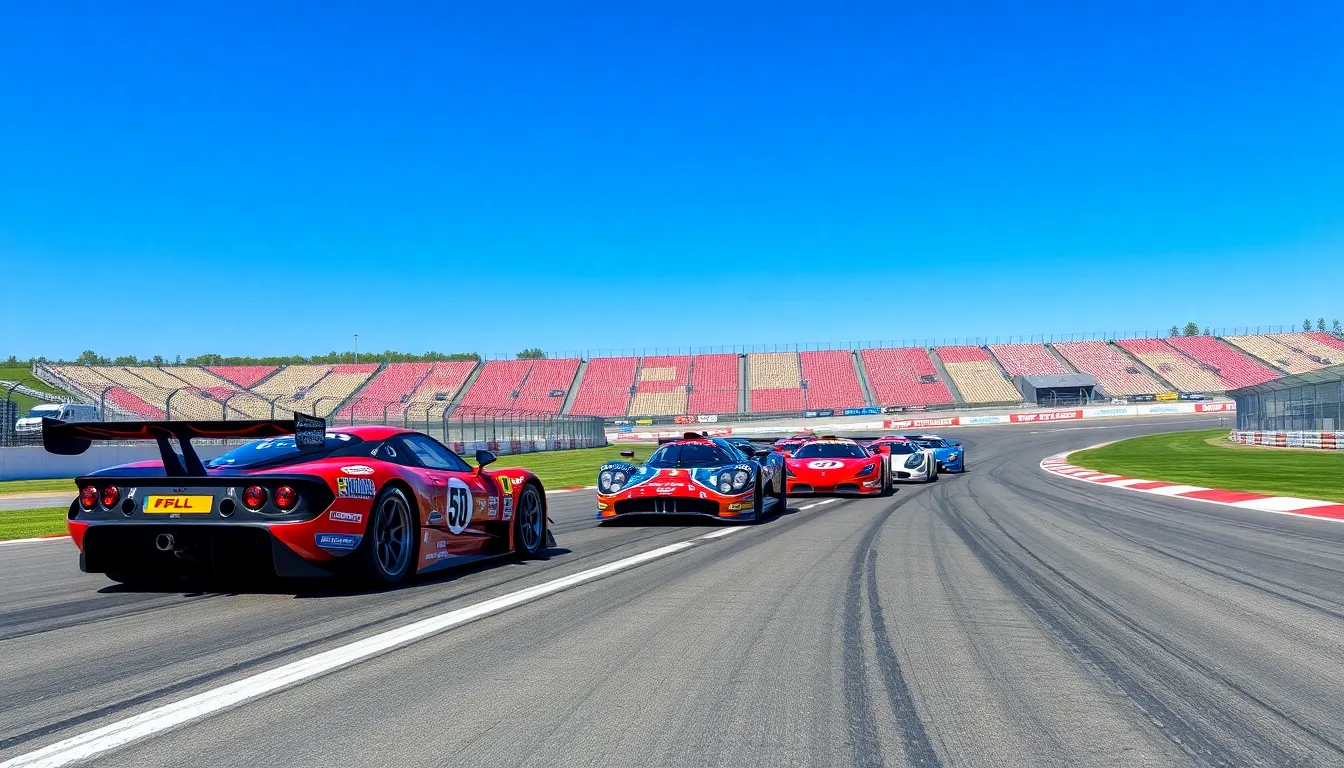Table of Contents
ToggleIn the high-octane world of motorsports, where every second counts, rolling starts have become the secret sauce that spices up the race. Imagine a scene where engines roar to life, tires screech, and drivers grip their steering wheels like they’re about to face a dragon. It’s not just a start; it’s a carefully choreographed dance of speed and strategy that sets the stage for exhilarating competition.
Overview Of Rolling Starts Racing
Rolling starts in racing mark the transition from stationary beginnings to dynamic acceleration, creating a unique atmosphere. They occur when cars line up in formation rather than starting from a complete stop. Drivers maintain a controlled speed, preparing for the green flag signal that initiates full racing intensity.
Strategically, rolling starts allow drivers to establish positioning before the race begins. This method enhances competition by reducing the risks of chaotic overtaking early on, which often leads to accidents. Each driver must remain aware of their surroundings, ensuring minimal disruption as they proceed.
Famous motorsports, such as NASCAR and Formula 1, frequently utilize rolling starts. These events emphasize the importance of timing and tactical maneuvers. Drivers often gauge each other’s speeds and potential movements while locked in their pre-race formations.
Preparation for rolling starts also involves tire temperature management. More grip on the track allows for better cornering and acceleration once the race officially starts. Teams often pre-condition their tires to optimize performance during these vital moments.
Rolling starts contribute excitement and strategy to racing events. They heighten anticipation for both drivers and spectators, enhancing the overall experience. Engaging styles of racing, like endurance and sports car racing, further showcase the thrilling dynamics of rolling starts. Teams, drivers, and fans alike appreciate the unique method of launching into high-speed competition.
The Mechanics Behind Rolling Starts

Rolling starts enhance racing dynamics and strategy, allowing drivers to prepare for an optimal launch. Understanding the mechanics involves recognizing how specific elements contribute to a smooth beginning.
Formation Lap Explained
During a formation lap, cars line up in their starting order, maintaining a controlled speed. This phase allows drivers to gauge track conditions while warming their tires. Drivers take this opportunity to communicate with their teams about any adjustments that may enhance performance. Key aspects also include assessing fuel levels and tuning the car settings based on initial observations of the track surface. Teams often emphasize the importance of spacing between cars to avoid collisions. Effective management of the formation lap sets the stage for a successful rolling start.
The Role of Pace Cars
Pace cars play a crucial role in maintaining speed consistency during the rolling start. They regulate the pace, ensuring all drivers remain in formation until the green flag waves. An experienced pace car driver makes the process smoother by controlling the speed and ensuring all cars stay close together. Communication with race officials also occurs to signal transition points related to track safety. The pace car typically leads the pack through corners, reducing the chances of chaos as the race gets underway. By setting the tone for speed and control, the pace car significantly contributes to the rolling start’s effectiveness.
Advantages Of Rolling Starts
Rolling starts enhance both safety and competitive fairness in racing.
Safety Considerations
Safety stands out as a primary advantage of rolling starts. Cars accelerate from a controlled speed, reducing the likelihood of dramatic collisions that often occur at stationary starts. Drivers maintain spacing, which allows for better reactions to sudden changes in track conditions. This careful formation helps prevent pile-ups that might arise during high-speed launches. Moreover, pace cars help regulate speed and ensure consistency, further minimizing risks as drivers approach the starting line. Consequently, drivers can focus on strategy rather than solely on speed at the start.
Competitive Fairness
Competitive fairness represents a significant benefit of rolling starts. Unlike traditional standing starts, rolling starts enable drivers to establish their positioning before the race begins. By aligning in formation, everyone gets an equal opportunity to develop momentum and control during the initial phase. This method discourages chaotic overtaking maneuvers, allowing for a more strategic approach to racing. It encourages tactical planning from drivers as they assess others’ speeds and positions. Consequently, rolling starts create a more balanced competition, setting the stage for an exciting race ahead.
Challenges Of Rolling Starts
Rolling starts present unique challenges for drivers and teams. Navigating these challenges requires strategy and awareness throughout the race.
Driver Strategies
Drivers must adapt their strategies during rolling starts to maintain optimal performance. Maintaining tire temperature plays a critical role in ensuring grip at the start. Assessing competitors’ positions helps drivers position themselves advantageously. Coordinated communication with teams enhances awareness of track conditions and tire performance. Adapting to the pace car’s speed becomes crucial, as any misjudgment can lead to lost positions. Recognizing the formation of cars allows drivers to anticipate potential overtakes and adjust their lines accordingly.
Impact on Race Dynamics
Rolling starts influence race dynamics from the outset. The initial formation impacts how drivers approach the first corner, as they need to gauge spacing between competitors. Increased acceleration potential leads to more intense competition immediately after the start. Establishing a quick rhythm allows drivers to build momentum efficiently. Additionally, the absence of chaotic jockeying at the start promotes a more strategic racing environment. Maintaining proper spacing helps reduce the likelihood of early collisions. Consistency in speed during the rolling start fosters smoother transitions into the race’s competitive dynamics.
Historical Context Of Rolling Starts Racing
Rolling starts originated as a solution to address safety concerns in motorsports. Early races often began with a complete stop, leading to chaotic clashes as drivers accelerated simultaneously. In response to frequent accidents, motorsport authorities considered alternatives that allowed drivers to merge speed with strategy.
NASCAR and Formula 1 were among the first series to adopt rolling starts into their formats, demonstrating the effectiveness of this method. These organizations recognized that controlled acceleration provided a safer environment while enhancing the competition’s excitement. Teams and drivers adjusted to this new style, focusing not just on speed, but also on managing tire temperatures and spacing within the pack.
The transition to rolling starts involved a learning curve for many drivers. Adaptation to the formation lap served as a critical phase for assessing track conditions and establishing momentum. Communication became vital during this phase, as teams guided drivers in optimizing performance through strategies that responded to immediate circumstances.
Significant events in motorsport history highlighted the benefits of rolling starts. Notable races showcased reduced accidents with fewer serious incidents during the early laps. Statistics confirmed that rolling starts led to a decrease in pile-ups compared to stationary starts, underscoring the safety improvements.
Overall, the historical shift to rolling starts reveals an evolution in racing that prioritizes both excitement and safety. Changes in rules over the decades reflect a commitment to continuous improvement in competitive motorsports. This evolution not only transformed race dynamics but also enhanced the spectator experience.
Rolling starts have transformed the landscape of motorsports by prioritizing safety and enhancing competitive dynamics. This method not only reduces the risks associated with chaotic starts but also fosters a more strategic racing environment. As drivers adapt their tactics to the unique challenges of rolling starts they engage in a thrilling competition that captivates audiences. The evolution from stationary to rolling starts reflects a commitment to improving both the excitement of the race and the safety of participants. With their continued use in prestigious events like NASCAR and Formula 1 rolling starts will undoubtedly remain a vital aspect of racing strategy for years to come.




